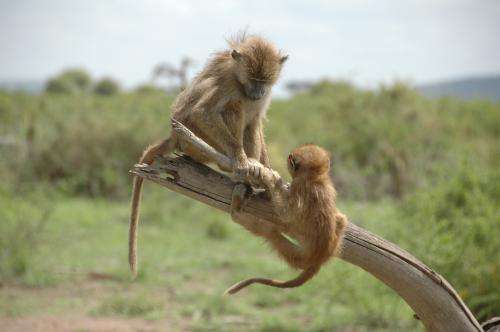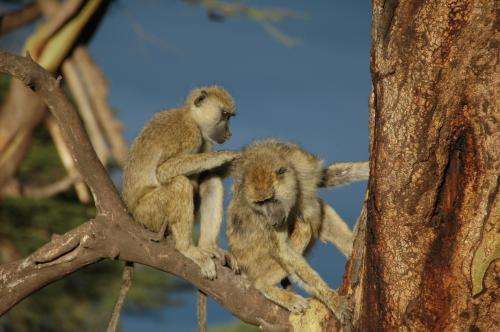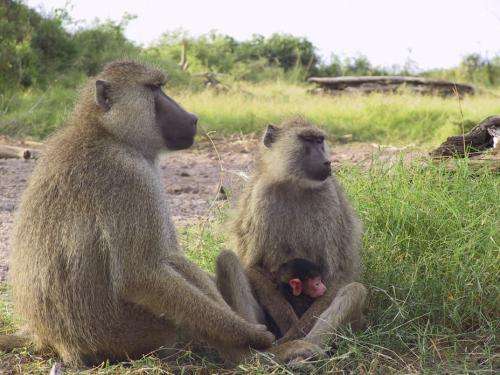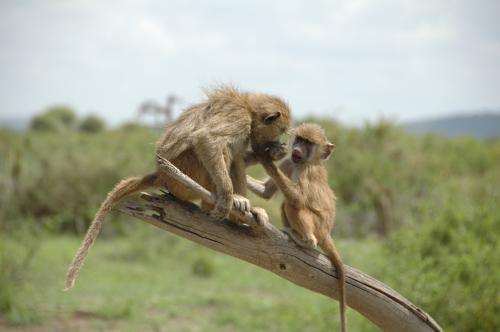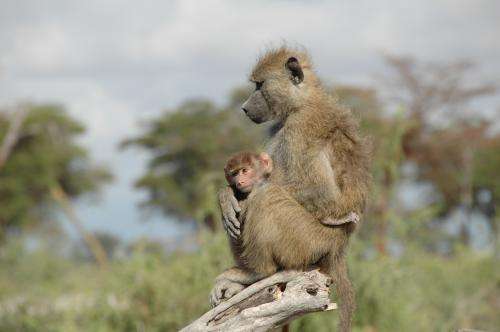A juvenile and an infant baboon play together on a tree snag in Amboseli. Credit: Susan Alberts
The saying "what doesn't kill you makes you stronger" may not hold up to scientific scrutiny.
After the plains of southern Kenya experienced a severe drought in 2009 that took a terrible toll on wildlife, researchers looked at how 50 wild baboons coped with the drought, and whether the conditions they faced in infancy played a role.
The semi-arid savanna of southern Kenya usually receives an average of 14 inches of rain a year—akin to much of Nebraska or Kansas—but in 2009 it fell to five inches, less than the Mojave Desert.
The year before wasn't much better: rainfall in 2008 dropped to half normal levels.
Grasslands withered
The grasslands the animals depend on for food dried up and watering holes disappeared, leaving many animals starving or weak from hunger.
"We lost 98 percent of the wildebeest population, 75 percent of the zebra population and 30 percent of the elephant population," said Susan Alberts, a biologist at Duke University. "It was impossible to go anywhere without smelling death."
Most baboons made it, but the drought left them underweight and many females stopped ovulating.
In a forthcoming paper in the journal American Naturalist, the researchers compared two groups of females—one group born during low rainfall years, the other born during normal rainfall years.
Adolescent female baboon grooming her mother. Credit: Susan Alberts
Born in a drought
All females in the study were adults by time of the 2009 drought, but those born in lean times fared worse in 2009 than those born in times of plenty, the researchers found.
"This study demonstrates lifetime fertility reductions for baboons born during stressful conditions or to low-ranking mothers," said George Gilchrist, program director in the National Science Foundation's (NSF) Division of Environmental Biology, which funded the research along with NSF's Divisions of Integrative Organismal Systems and Behavioral and Cognitive Sciences.
"These 'disadvantaged' early life experiences are linked with less resilience to stressful conditions experienced as adults."
During the 2009 drought, baboons born during low rainfall years were 60 percent less likely to become pregnant, whereas pregnancy rates dipped by only 10 percent for females born during normal rainfall years.
Drought babies born to higher-status mothers were less affected by the 2009 event.
"It might be that baboons born to higher-ranked moms have better access to food, or suffer lower levels of social stress," Alberts said.
Implications for human health
Adult female baboon with a one-day-old infant, sitting with an adult male baboon. Credit: Susan Alberts
The findings also help explain why people who are malnourished in early childhood go on to have higher rates of obesity, diabetes and heart disease as adults.
Some researchers argue that human babies conceived or born in lean times are programmed for food shortages later in life.
They develop a "thrifty metabolism," aimed at storing fat and conserving energy in order to survive starvation.
Things go awry, the thinking goes, only when the environments they experienced as infants and as adults don't match, such as when a child conceived in famine grows up and eats an excess of cheeseburgers, said paper co-author Amanda Lea, a biologist at Duke.
Infant baboon reaching toward an older juvenile who is feeding. Credit: Susan Alberts
But the baboon fertility study lends support to another idea, namely that kids who don't get enough to eat during their first year of life are simply less resilient as adults than their counterparts.
"The data suggest that early adversity carries lifelong costs," said co-author Jenny Tung, a biologist at Duke.
"It's bad to be born in bad times, but with the right social or economic environment, that can be mitigated," Alberts added.
Juvenile male baboon holding his young infant brother. Credit: Susan Alberts
More information: "Developmental constraints in a wild primate" www.amnat.org/an/newpapers/JuneLea.html
Journal information: American Naturalist
Provided by National Science Foundation
